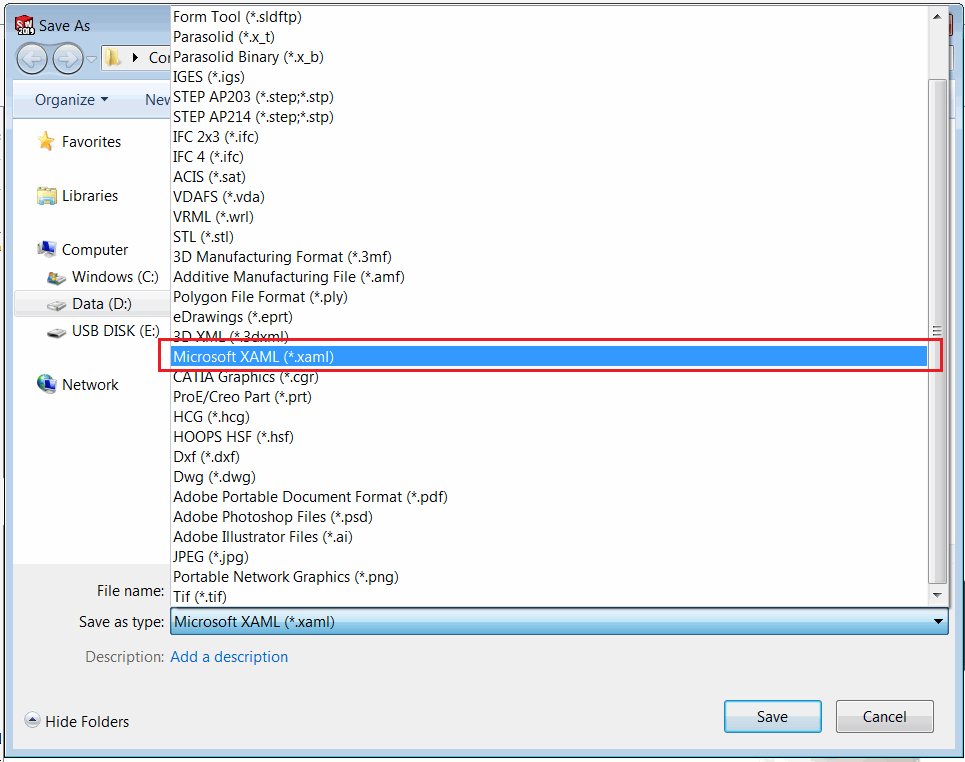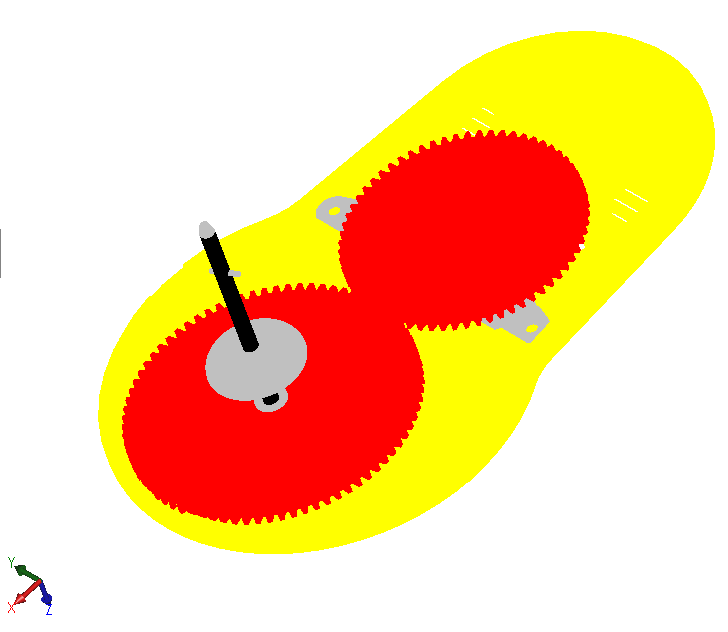使用OpenGL和SOLIDWORKS API导入和渲染XAML文件
这个C#插件演示了如何使用SOLIDWORKS API将XAML文件中的几何图形导入到活动模型空间中。为了实现最大的性能,图形使用OpenGL的顶点缓冲对象(VBO)功能进行渲染。
使用OpenTK库来调用OpenGL API。
插件只能导入从零件文档创建的XAML文件(不支持从装配体导出的XAML文件)。
XAML文件是SOLIDWORKS原生支持的导出格式。使用文件->另存为菜单命令以XAML格式导出文件。
 { width=550 }
{ width=550 }
然而,这种格式不能被原生导入。插件将导入XAML文件命令添加到菜单中。打开新文件或现有文件,并使用此命令导入xaml。
{ width=450 }
图形使用OpenGL进行渲染。模型可以旋转、缩放、平移。没有创建特征元素或临时体,图形以高性能渲染。
 { width=350 }
{ width=350 }
默认情况下,OpenGL的图形不会受到缩放命令的影响。例如,适应窗口命令不会正确适应几何图形,并且会忽略其边界框。要指定可见边界,需要使用SOLIDWORKS API的IModelDocExtension::SetVisibleBox方法。注意,不需要将原生SOLIDWORKS几何图形的现有可见框合并,SOLIDWORKS将自动执行此操作。
源代码可以从GitHub下载。
AddIn.cs
这是插件的入口点。使用SwEx.AddIn框架通过提供包装类来管理文档生命周期。导入命令在插件中处理,并从指定的XAML文件中提取出Microsoft WPF框架的Model3DGroup对象。
using CodeStack.SwEx.AddIn;
using CodeStack.SwEx.AddIn.Attributes;
using CodeStack.SwEx.AddIn.Base;
using CodeStack.SwEx.AddIn.Enums;
using CodeStack.SwEx.Common.Attributes;
using CodeStack.XamlImporter.Properties;
using SolidWorks.Interop.swconst;
using System;
using System.IO;
using System.Linq;
using System.Runtime.InteropServices;
using System.Windows.Controls;
using System.Windows.Forms;
using System.Windows.Markup;
using System.Windows.Media.Media3D;
namespace CodeStack.XamlImporter
{
[Guid("1F872F6B-525E-4889-862E-B7A8C27C398C"), ComVisible(true)]
[AutoRegister("XamlImporter")]
public class AddIn : SwAddInEx
{
[Icon(typeof(Resources), nameof(Resources.xaml))]
[Title("OpenGL Import Xaml")]
private enum Commands_e
{
[Icon(typeof(Resources), nameof(Resources.xaml))]
[Title("Import XAML File")]
[CommandItemInfo(swWorkspaceTypes_e.Part | swWorkspaceTypes_e.Assembly)]
ImportXamlFile
}
private IDocumentsHandler<MeshRendererModel> m_DocsHandler;
public override bool OnConnect()
{
AddCommandGroup<Commands_e>(OnButtonClick);
m_DocsHandler = CreateDocumentsHandler<MeshRendererModel>();
return true;
}
private void OnButtonClick(Commands_e cmd)
{
switch (cmd)
{
case Commands_e.ImportXamlFile:
try
{
using (var openFileDlg = new OpenFileDialog())
{
openFileDlg.Filter = "Microsoft XAML Files (*.xaml)|*.xaml|All Files (*.*)|*.*";
openFileDlg.RestoreDirectory = true;
if (openFileDlg.ShowDialog() == DialogResult.OK)
{
var xamlFilePath = openFileDlg.FileName;
var model = GetModel3DFromFile(xamlFilePath);
m_DocsHandler[App.IActiveDoc2].Model3D = model;
}
}
}
catch(Exception ex)
{
App.SendMsgToUser2(ex.Message, (int)swMessageBoxIcon_e.swMbStop, (int)swMessageBoxBtn_e.swMbOk);
}
break;
}
}
private Model3DGroup GetModel3DFromFile(string file)
{
if (File.Exists(file))
{
using (var fileStream = File.OpenRead(file))
{
var viewPort = XamlReader.Load(fileStream) as Viewport3D;
var modelVisual = viewPort.Children.First() as ModelVisual3D;
modelVisual = modelVisual.Children.Last() as ModelVisual3D;
var model = modelVisual.Content as Model3DGroup;
if (model == null)
{
throw new InvalidCastException("Content is not Model3DGroup");
}
return model;
}
}
else
{
throw new FileNotFoundException($"File {file} doesn't exist");
}
}
}
}
MeshRendererModel.cs
这是每个模型文档的处理程序类,它订阅了SOLIDWORKS提供的OpenGL缓冲区交换通知,并根据提供的网格数据执行VBO的绑定和渲染。
using CodeStack.SwEx.AddIn.Base;
using System;
using System.Collections.Generic;
using System.Linq;
using SolidWorks.Interop.sldworks;
using System.Windows.Media.Media3D;
using OpenTK;
using OpenTK.Graphics.OpenGL;
using System.Windows.Media;
namespace CodeStack.XamlImporter
{
public class MeshRendererModel : IDocumentHandler
{
private IMathUtility m_MathUtils;
private IModelDoc2 m_Model;
private ModelView m_View;
private GLControl m_GLControl;
private bool m_IsBufferInit;
private int m_ColorBufferId;
private int m_ElementBufferId;
private int m_NormalBufferId;
private int m_VertexBufferId;
private int m_IndicesCount;
private Model3DGroup m_Model3D;
public Model3DGroup Model3D
{
get
{
return m_Model3D;
}
set
{
m_Model3D = value;
UpdateVisibleBox();
m_IsBufferInit = false;
m_Model.GraphicsRedraw2();
}
}
public void Init(ISldWorks app, IModelDoc2 model)
{
m_MathUtils = app.IGetMathUtility();
m_View = model.IActiveView;
if (m_View != null)
{
m_View.BufferSwapNotify += OnBufferSwapNotify;
m_GLControl = new GLControl();
m_GLControl.Context.MakeCurrent(null);
}
else
{
throw new NullReferenceException("No active view");
}
m_Model = model;
}
public void Dispose()
{
if (m_View != null)
{
m_View.BufferSwapNotify += OnBufferSwapNotify;
}
m_GLControl.Dispose();
}
private int OnBufferSwapNotify()
{
if (m_Model3D != null)
{
if (!m_IsBufferInit)
{
InitBuffer();
m_IsBufferInit = true;
}
RenderBuffer();
}
return 0;
}
private void UpdateVisibleBox()
{
m_Model.Extension.RemoveVisibleBox();
if (m_Model3D != null)
{
var curBox = m_Model3D.Bounds;
var pt1 = m_MathUtils.CreatePoint(new double[] { curBox.X, curBox.Y, curBox.Z }) as MathPoint;
var pt2 = m_MathUtils.CreatePoint(new double[] { curBox.X + curBox.SizeX, curBox.Y + curBox.SizeY, curBox.Z + curBox.SizeZ }) as MathPoint;
m_Model.Extension.SetVisibleBox(pt1, pt2);
}
}
private void InitBuffer()
{
var posList = new List<Vector3d>();
var indList = new List<uint>();
var normList = new List<Vector3d>();
var colList = new List<uint>();
int indicesOffset = 0;
if (m_Model3D != null)
{
foreach (var geometryModel in m_Model3D.Children)
{
var geometryModel3d = geometryModel as GeometryModel3D;
if (geometryModel3d != null)
{
var color = Colors.Black;
var materialGrp = geometryModel3d.Material as MaterialGroup;
var material = materialGrp?.Children?.FirstOrDefault() as DiffuseMaterial;
if (material != null)
{
if (material.Brush is SolidColorBrush)
{
color = (material.Brush as SolidColorBrush).Color;
}
}
var geom = geometryModel3d.Geometry as MeshGeometry3D;
if (geom != null)
{
indList.AddRange(geom.TriangleIndices.Select(i => (uint)(i + indicesOffset)));
indicesOffset += geom.Positions.Count;
foreach (var pos in geom.Positions)
{
posList.Add(new Vector3d(pos.X, pos.Y, pos.Z));
colList.Add(ColorToArgb(color));
}
foreach (var norm in geom.Normals)
{
normList.Add(new Vector3d(norm.X, norm.Y, norm.Z));
}
}
else
{
throw new NotSupportedException("Only MeshGeometry3D is supported");
}
}
else
{
throw new NotSupportedException("Only GeometryModel3D is supported");
}
}
GenAndFillBuffer(posList.ToArray(), BufferTarget.ArrayBuffer, out m_VertexBufferId);
GenAndFillBuffer(colList.ToArray(), BufferTarget.ArrayBuffer, out m_ColorBufferId);
GenAndFillBuffer(normList.ToArray(), BufferTarget.ArrayBuffer, out m_NormalBufferId);
GenAndFillBuffer(indList.ToArray(), BufferTarget.ElementArrayBuffer, out m_ElementBufferId);
m_IndicesCount = indList.Count;
}
}
private void RenderBuffer()
{
GL.Disable(EnableCap.Lighting);
GL.BindBuffer(BufferTarget.ArrayBuffer, m_NormalBufferId);
GL.NormalPointer(NormalPointerType.Double, Vector3d.SizeInBytes, IntPtr.Zero);
GL.EnableClientState(ArrayCap.NormalArray);
GL.BindBuffer(BufferTarget.ArrayBuffer, m_VertexBufferId);
GL.VertexPointer(3, VertexPointerType.Double, Vector3d.SizeInBytes, IntPtr.Zero);
GL.EnableClientState(ArrayCap.VertexArray);
GL.BindBuffer(BufferTarget.ArrayBuffer, m_ColorBufferId);
GL.ColorPointer(4, ColorPointerType.UnsignedByte, sizeof(int), IntPtr.Zero);
GL.EnableClientState(ArrayCap.ColorArray);
GL.BindBuffer(BufferTarget.ElementArrayBuffer, m_ElementBufferId);
GL.DrawElements(PrimitiveType.Triangles, m_IndicesCount, DrawElementsType.UnsignedInt, IntPtr.Zero);
}
private uint ColorToArgb(Color color)
{
return (uint)color.A << 24 | (uint)color.B << 16 | (uint)color.G << 8 | (uint)color.R;
}
private void GenAndFillBuffer<T>(T[] dataBuffer, BufferTarget target, out int bufferId)
where T : struct
{
GL.GenBuffers(1, out bufferId);
GL.BindBuffer(target, bufferId);
var size = dataBuffer.Length * BlittableValueType.StrideOf(dataBuffer);
GL.BufferData(target, new IntPtr(size), dataBuffer, BufferUsageHint.StaticDraw);
int bufferSize;
GL.GetBufferParameter(target, BufferParameterName.BufferSize, out bufferSize);
if (size != bufferSize)
{
throw new Exception("Buffer size mismatch");
}
GL.BindBuffer(target, 0);
}
}
}